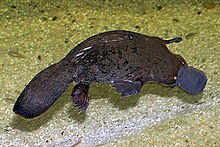Monotreme
Monotremes are basal mammals that lay eggs (Prototheria) instead of giving birth to live young like marsupials (Metatheria) and placental mammals (Eutheria). The only surviving examples of monotremes are all indigenous to Australia and New Guinea, although there is evidence that they were once more widespread. The existing monotreme species are the platypus and four species of echidnas. There is currently some debate regarding monotreme taxonomy.
The word monotreme comes from the Greek μονός, monos ("single") and τρῆμα, trema ("hole"), referring to the cloaca
General Characteristics
Like other mammals, monotremes are warm-blooded with a high metabolic rate (though not as high as other mammals; see below); have hair on their bodies; produce milk through mammary glands to feed their young; have a single bone in their lower jaw; and have three middle-ear bones.
In common with reptiles and marsupials, monotremes lack the connective structure (corpus callosum) which in placental mammals is the primary communication route between the right and left brain hemispheres.[3] The anterior commissure does provide an alternate communication route between the two hemispheres, though, and in monotremes and marsupials it carries all the commissural fibers arising from the neocortex, whereas in placental mammals the anterior commissure carries only some of these fibers.[4]
Extant monotremes lack teeth as adults. Fossil forms and modern platypus young have a "tribosphenic" form of molars (with the occlusal surface formed by three cusps arranged in a triangle), which is one of the hallmarks of extant mammals. Some recent work suggests that monotremes acquired this form of molar independently of placental mammals and marsupials,[5] although this is not well established.[6]Toothloss in modern monotremes might be related to their development of electrolocation.[7]
Monotreme jaws are constructed somewhat differently from those of other mammals, and the jaw opening muscle is different. As in all true mammals, the tiny bones that conduct sound to the inner ear are fully incorporated into the skull, rather than lying in the jaw as in cynodonts and other premammalian synapsids; this feature, too, is now claimed to have evolved independently in monotremes and therians,[8] although, as with the analogous evolution of the tribosphenic molar, this is disputed.[9][10] Nonetheless, findings on the extinct species Teinolophos confirm that suspended ear bones evolved independently among monotremes and therians.[11] The external opening of the ear still lies at the base of the jaw.
The sequencing of the platypus genome has also provided insight into the evolution of a number of monotreme traits, such as venom and electroreception, as well as showing some new unique features, such as the fact that monotremes possess 10 sex chromosomes and that their X chromosome resembles the sex chromosome of birds,[12] suggesting that the two sex chromosomes of marsupial and placental mammals evolved more recently than the split from the monotreme lineage.[13] This feature, along with some other genetic similarities with birds, such as shared genes related to egg-laying, is thought to provide some insight into the most recent common ancestor of the synapsid lineage leading to mammals and the sauropsid lineage leading to birds and modern reptiles, which are believed to have split about 315 million years ago during the Carboniferous.[14][15] The presence of vitellogenin genes (a protein necessary for egg shell formation) is shared with birds, suggesting that when the common ancestor of mammals from ~225 million years ago split into monotremes, marsupials, and placental mammals, egg laying was retained in monotremes and lost in all other mammals. DNA suggests that while this trait is shared and is synapomorphic with birds, platypuses are still mammals and they evolved lactation with other mammals.[16] L-ascorbic acid is synthesized only in the kidneys.monotremes also have extra bones in the shoulder girdle, including an interclavicle and coracoid, which are not found in other mammals. Monotremes retain a reptile-like gait, with legs on the sides of, rather than underneath, their bodies. The monotreme leg bears a spur in the ankle region; the spur is not functional in echidnas, but contains a powerful venom in the male platypus. This venom is derived from b-defensins, proteins that are present in mammals that create holes in viral and bacterial pathogens. Some reptile venom is also composed of different types of b-defensins, another trait shared with reptiles. It is thought to be an ancient mammalian characteristic, as many non-monotreme archaic mammal groups also possess venomous spurs.



Walang komento:
Mag-post ng isang Komento